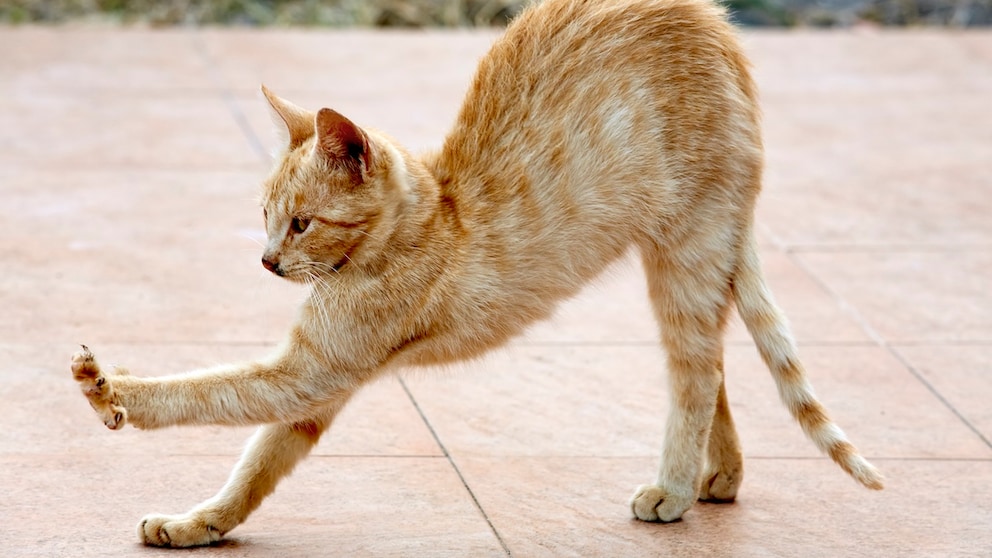July 19, 2024, 3:51 am | Read time: 4 minutes
The arch in cats backs is so well-known that even a yoga pose has even been named after it. But what does it actually mean in animal body language? PETBOOK editor Louisa Stoeffler explains what cats want to express with it.
When cats sit down neatly, their backs show a noticeable curve. But is the cat showing what is known as a cat arch? Some experienced cat owners may say, “No, cats only arch their backs when they are in a bad mood.” But that’s not quite true. There can be various reasons and moods for a cat hump.
The cat arches and walks sideways
My cat Remo often arches his back in play when he pretends to run towards prey. He also raises his tail to show that he is excited. With this behavior, he expresses all his energy, especially when he tries to catch bouncy balls or fishing rod toys. Sometimes he also makes a playful, threatening gesture and runs towards me as if to say, “Don’t come too close, can’t you see I’m threatening you?”, which always makes me laugh. This positive reaction on my part naturally reinforces the behavior, so Remo likes to show it often.
Arching the back while scent marking
Especially when male cats are not yet neutered and reach puberty, they display a marking behavior in which they raise their tail upwards and round their back into an arch. They then release a stream of foul-smelling urine.
Signs of aggression
A common reason, which is often shown in the species-specific communication of cats, is the arch, which is formed out of aggression. If a strange cat suddenly appears in their territory, cats will usually approach each other with an arch. This makes them look bigger, with the hair on their tail and back standing up and the tail hanging down like a question mark. If the cat is ready to defend or attack, it also indicates this with hissing or a low growl.1
Cats arch their backs because they are afraid or stressed
This can occur in communication with other cats, but also with their owner. In this case, the cat that feels insecure also puts its ears back or licks its lips to calm itself down while having its tail between its legs.2
Attention
When communicating with humans, cats often take advantage of the fact that the arch makes them look bigger. So if the cat shows its arched back and looks at its owner with open and dilated pupils, it probably wants attention. Remo also sticks his paw out at me if the arch signal has not reached me clearly enough.
Stretching exercise
Often, cats also arch briefly, especially after sleeping, because they want to stretch extensively. I personally notice this after work. Remo has a good sense of timing when it’s getting close to the end of the working day. He stretches on his blanket on my desk and presses all four paws into the fabric with relish. He then stretches his back into an arch. Then he stretches his front legs out long and looks up with his head. You could almost think he is doing relaxation yoga.
Arching while presenting the head
When the cat stretches towards the owner’s hand to express affection and solicit petting, it often arches its back. Remo shows this behavior especially in the morning when we go to the bathroom. He then looks at me invitingly, even vocalizing with meows that it is now time to stroke him. If I then reach out for him while I’m sleepy, he gives me his head first. If I stroke him too slowly or not enough, he will arch his back and stroke my hand.
Displacement behavior
Young kittens, in particular, often show a completely exaggerated reaction to a toy or to their food. This is an exuberant action, whereby they not only arch, but also playfully hop and perform other antics. In playful cats, at least, the arching continues into old age.

Nerve disease? What is known about incurable rolling skin syndrome in cats

Behavior explained Why do cats show us their bottoms?

Behavior explained 4 reasons why cats stare at people continuously
When an arch is the cat’s warning sign
Arching their backs is, therefore, a versatile means of communication for cats. However, you should be concerned if the cat frequently arches its back and appears aggressive. Or if it even hisses or swats at people or other animals with its paw. This can be a sign that they feel completely uncomfortable in their current situation or social group.
If the cat all of a sudden arches its back excessively often, this can also be a sign of an undiagnosed pain.
Finally, an arch can also be a sign of joint problems. I once met an older cat who was very reluctant to be stroked on the back because he already had osteoarthritis in his hip joints. Whenever you inadvertently stroked his back, he would arch his back to prevent you from touching the painful area. If you did touch him there, he would push his back down3

